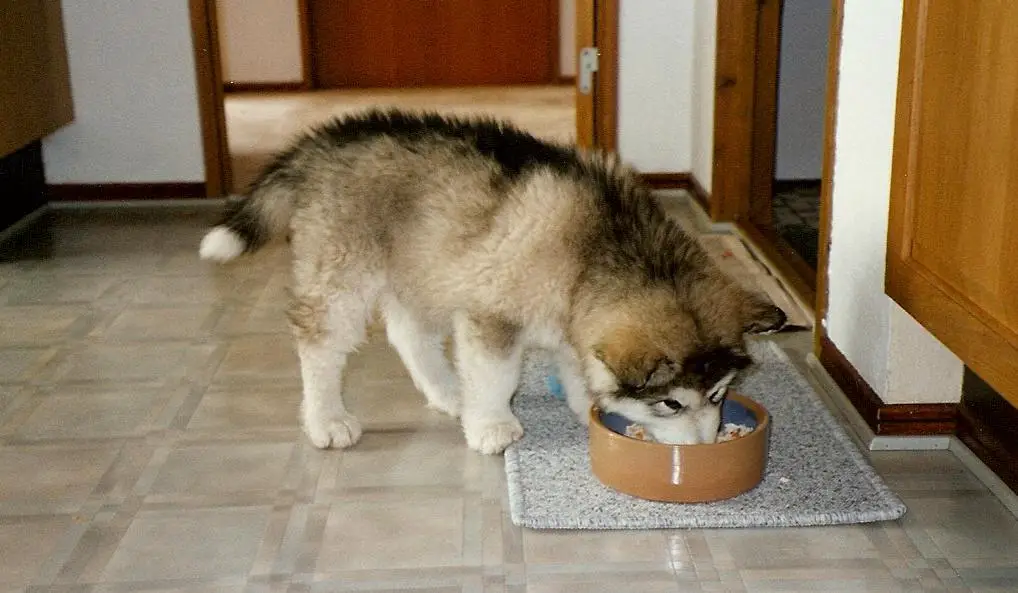Introducing a new feeding routine to your puppy can be a challenging task. Puppies often form strong attachments to their feeding routines and changing them can trigger anxiety and stress.
However, changing a feeding routine is sometimes necessary, especially if your puppy needs to lose weight, has food allergies, or has health issues that require a specific diet.
In this article, we’ll explore some tips and tricks to help your puppy adjust to a new feeding routine with as little stress as possible.
From gradually transitioning their food to offering treats and positive reinforcement, we’ll cover everything you need to know to make the process as easy and smooth as possible.
- How To Assess The Puppy’s Current Feeding Routine
- How To Plan a New Feeding Routine For Your Puppy
- 1. Consultation with a veterinarian for personalized guidance
- 2. Selecting an appropriate feeding schedule
- 3. Frequency of meals
- 4. Portion sizes
- 5. Timing of meals in relation to daily activities
- 6. Choosing the right food
- 7. Nutritional requirements for your puppy’s age, breed, and size
- 8. Quality of ingredients and product reputation
- 9. Special Dietary needs or restrictions
- How To Gradually Introduce The New Feeding Routine To Your Puppy
- 1. Slowly adjust meal times
- 2. Shifting meal times incrementally
- 3. Allowing time for your puppy to adapt to new meal times
- 4. Transitioning to new food
- 5. Mixing old and new food in gradually increasing ratios
- 6. Monitoring for any signs of digestive upset
- 7. Creating a consistent and positive feeding environment
- 8. Designating a specific feeding area
- 9. Minimizing distractions during meal times
- 10. Incorporating positive reinforcement and praise
- 11. Monitoring your puppy’s adjustment to the new feeding routine
- In Conclusion
Helping Your Puppy Adjust To a New Feeding Routine
How To Assess The Puppy’s Current Feeding Routine

Assessing your puppy’s current feeding routine is an essential step to ensure their health and well-being. Here are some factors to consider when evaluating your puppy’s current feeding routine:
1. Evaluating the suitability of the current feeding schedule
Before making any changes, it’s essential to evaluate whether your puppy’s current feeding schedule is suitable for its age, weight, and activity level.
Consider whether your puppy is:
- Getting enough food to maintain a healthy weight
- Eating frequently enough to support their growth and development
- Receiving the nutrients they need for optimal health
- Avoiding food-related health issues, such as overeating or upset stomachs
2. Determining whether a change is necessary
If you’ve determined that your puppy’s current feeding schedule is not suitable, it may be time to make some changes. Here are some factors to consider when determining whether a change is necessary:
3. Age and developmental milestones
Puppies have different nutritional needs at different stages of their development. For example, younger puppies require more frequent feedings to support their rapid growth and development, while older puppies may need fewer feedings as they become more independent.
Evaluating your puppy’s age and corresponding developmental milestones can help you determine whether it’s time to adjust its feeding schedule.
4. Health or dietary requirements
If your puppy has a health condition or dietary requirement, such as food allergies, you may need to adjust their feeding schedule to accommodate their specific needs.
Consulting with your veterinarian can help you determine whether a change in diet is necessary to improve your puppy’s health and well-being.
5. Changes in lifestyle or family schedule
Changes in lifestyle or family schedule can also impact your puppy’s feeding routine. For example, if you’re working long hours or your puppy is experiencing changes in their environment, you may need to adjust their feeding schedule to accommodate these changes.
By considering these factors when evaluating your puppy’s current feeding routine, you can determine whether changes are necessary, and take steps to create a new feeding routine that supports their optimal health and well-being.
Remember to consult with your veterinarian to ensure that any adjustments made align with your puppy’s specific nutritional needs.
See also: 56 Safe Vegetables To Feed Your Dog. Puppy Power!
Helping Your Puppy Adjust To a New Feeding Routine
How To Plan a New Feeding Routine For Your Puppy

Planning a new feeding routine for your puppy is an important part of ensuring their ongoing health and well-being. Here are some key considerations when creating a new feeding routine:
1. Consultation with a veterinarian for personalized guidance
Before making any significant changes to your puppy’s diet, it is crucial to consult with a veterinarian. Your veterinarian can assess your puppy’s overall health and help you determine the best feeding schedule and food options for your individual puppy.
A veterinarian can provide personalized guidance on factors such as breed, age, size, weight, and any health concerns that may influence your puppy’s nutritional needs.
2. Selecting an appropriate feeding schedule
When creating a new feeding routine, it’s important to choose an appropriate feeding schedule. Here are some key factors to consider:
3. Frequency of meals
Younger puppies need more frequent feedings – typically three to four times per day – to support their rapid growth and development, while older puppies can typically be fed two meals per day.
4. Portion sizes
Feeding your puppy appropriate portion sizes can help maintain a healthy weight and avoid overeating or other food-related health issues. Your veterinarian can provide guidance on appropriate portion sizes for your puppy’s age, weight, and activity level.
5. Timing of meals in relation to daily activities
Consider scheduling feedings around your puppy’s daily activities, such as walks and playtime. Waiting a little while after your puppy has exercised before feeding them can help prevent tummy issues.
6. Choosing the right food
Choosing the right food for your puppy is essential for their overall health and well-being. Here are some key factors to consider:
7. Nutritional requirements for your puppy’s age, breed, and size
Different age groups, breeds, and sizes of dogs have varying nutritional requirements. Consult with your veterinarian to determine the right nutritional balance for your puppy.
8. Quality of ingredients and product reputation
Look for high-quality food products that contain healthy, whole-food ingredients, and avoid foods with added sugars and fillers. Do your research into the reputations of food products you consider, to ensure that they are safe and of good quality.
9. Special Dietary needs or restrictions
Some puppies have specific dietary needs or restrictions, such as food allergies or intolerance. Ensuring that you meet their unique requirement can be challenging, but it is important to avoid exacerbating any medical issues or discomfort.
Creating a new feeding routine for your puppy takes time and effort, but it is important for ensuring their continued good health.
By working with a veterinarian and carefully considering factors such as feeding schedules, portion sizes, and food quality, you can develop a plan that works best for your puppy’s individual nutritional needs.
Helping Your Puppy Adjust To a New Feeding Routine
How To Gradually Introduce The New Feeding Routine To Your Puppy
Gradually introducing a new feeding routine to your puppy is essential in order to ensure a smooth transition and minimize any stress or discomfort.
Here are some key strategies for gradually introducing a new feeding routine to your puppy:
1. Slowly adjust meal times
Gradually adjust your puppy’s meal times by 10-15 minutes each day, starting a week or two before you plan to introduce the new feeding routine.
2. Shifting meal times incrementally
Continue to shift meal times incrementally every day until they are in line with the new feeding routine.
3. Allowing time for your puppy to adapt to new meal times
Allow your puppy time to adjust to the new meal times before making any further changes to their feeding routine.
4. Transitioning to new food
If you’re introducing a new type of food, gradually transition your puppy over several days by mixing increasing amounts of the new food with their old food.
5. Mixing old and new food in gradually increasing ratios
Start with a ratio of 25% new food and 75% old food and gradually increase the new food to make up 100% of the meal over several days.
6. Monitoring for any signs of digestive upset
Keep a close eye on your puppy for any signs of digestive upset, such as vomiting or diarrhea.
7. Creating a consistent and positive feeding environment
Create a consistent and positive feeding environment by feeding your puppy in the same location every day and minimizing distractions, such as loud noises or other pets.
8. Designating a specific feeding area
Designate a specific feeding area where your puppy can eat without distractions or interruptions.
9. Minimizing distractions during meal times
Remove any distractions during meal times, such as toys or other pets in the area.
10. Incorporating positive reinforcement and praise
Incorporate positive reinforcement and praise to encourage your puppy to adopt its new feeding routine. This can include verbal praise, treats, and pets and cuddles after meal times.
11. Monitoring your puppy’s adjustment to the new feeding routine
Observe changes in your puppy’s appetite, energy levels, and overall well-being, and look out for any potential health issues related to the new feeding routine. If you notice anything unusual or concerning, consult with your veterinarian as soon as possible.
By gradually introducing a new feeding routine and monitoring your puppy’s adjustment, you can ensure a smooth and stress-free transition to a healthier diet and happier puppy.
Helping Your Puppy Adjust To a New Feeding Routine
In Conclusion
Adjusting to a new feeding routine can be a challenging process, not just for puppies, but also for their owners.
However, with patience, consistency, and the right tools, it is possible to introduce a new feeding routine without causing too much stress for your furry friend.
By following the tips and tricks outlined in this article, you can help your puppy make a successful transition to a new diet and ensure their overall health and well-being.
So, take it slow, be patient, and always remember to give your pup plenty of positive reinforcement along the way.





Leave a Reply